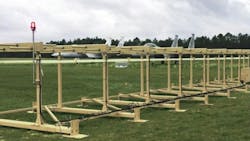Air Force asks Thales to build six more deployable air traffic control systems for unimproved locations
HANSCOM AIR FORCE BASE, Mass. – Military air traffic control experts at The Thales Group Air Traffic Management segment in Clarksburg, Md., will build six additional deployable instrumental landing systems for the U.S. Air Force under terms of a $21.8 million order announced Wednesday.
Officials of the Air Force Life Cycle Management Center at Hanscom Air Force Base, Mass., are asking Thales for six new Deployable Instrument Landing Systems (D-ILS) for precision aircraft approach and air traffic control worldwide in difficult conditions.
The D-ILS provides a system of equal performance to existing Category I fixed-based systems that provide aircraft guidance on final approach in low visibility and low-ceiling weather conditions at unimproved locations. The order is a modification to an $18.4 million contract the Air Force awarded to Thales in July 2015 to build two D-ILS prototypes for operational test and evaluation.
Air Force air traffic control experts used the original two D-ILS prototypes to evaluate a fixed-base instrument landing system at tactical airfields and at airfields where permanent ILS capability has been disrupted by events such as natural disaster or humanitarian relief efforts.
Related: Army begins acceptance of mobile military air traffic control towers from Sierra Nevada
While a fixed-base ILS is large and requires several aircraft to deliver all the equipment, the deployable ILS will fit onto one C-130 aircraft, Air Force officials say.
Thales finished D-ILS development in mid-2017. The company won a $12.3 million contract in July 2018 to build 29 D-ILS systems, and a $30.6 million order in November 2018 to build nine systems, before this week's $21.8 million order for an additional six D-ILS systems.
The Thales D-ILS provides precision guidance to fixed-wing aircraft and helicopters in separate environmentally diverse regions. Each system provides guidance based on the aircraft's position in relation to the final approach course glide path from the touchdown point on the runway or landing surface.
The goal is to provide the Air Force with supportable, adaptable, resilient, enduring, and persistent precision-approach capability that all joint, coalition, and civil ILS-equipped aircraft will be able to use worldwide.
Related: Raytheon introduces Mobile Air Traffic Control System
The D-ILS provides significantly improved reliability, maintainability and supportability over legacy deployable Precision Approach Radar (PAR) systems, Air Force officials say.
The Thales D-ILS offers remote monitoring and maintenance that allows for maintenance configuration from remote locations. It involves setting up a remote maintenance center in theater for central depot storage all maintenance items to sustain D-ILS installations at several different airfields.
On this order Thales will do the work in Clarksburg, Md., and should be finished by June 2022. For more information contact Thales Group Air Traffic Management online at www.thalesgroup.com, or the Air Force Life Cycle Management Center at www.wpafb.af.mil/aflcmc.
About the Author
John Keller
Editor-in-Chief
John Keller is the Editor-in-Chief, Military & Aerospace Electronics Magazine--provides extensive coverage and analysis of enabling electronics and optoelectronic technologies in military, space and commercial aviation applications. John has been a member of the Military & Aerospace Electronics staff since 1989 and chief editor since 1995.
